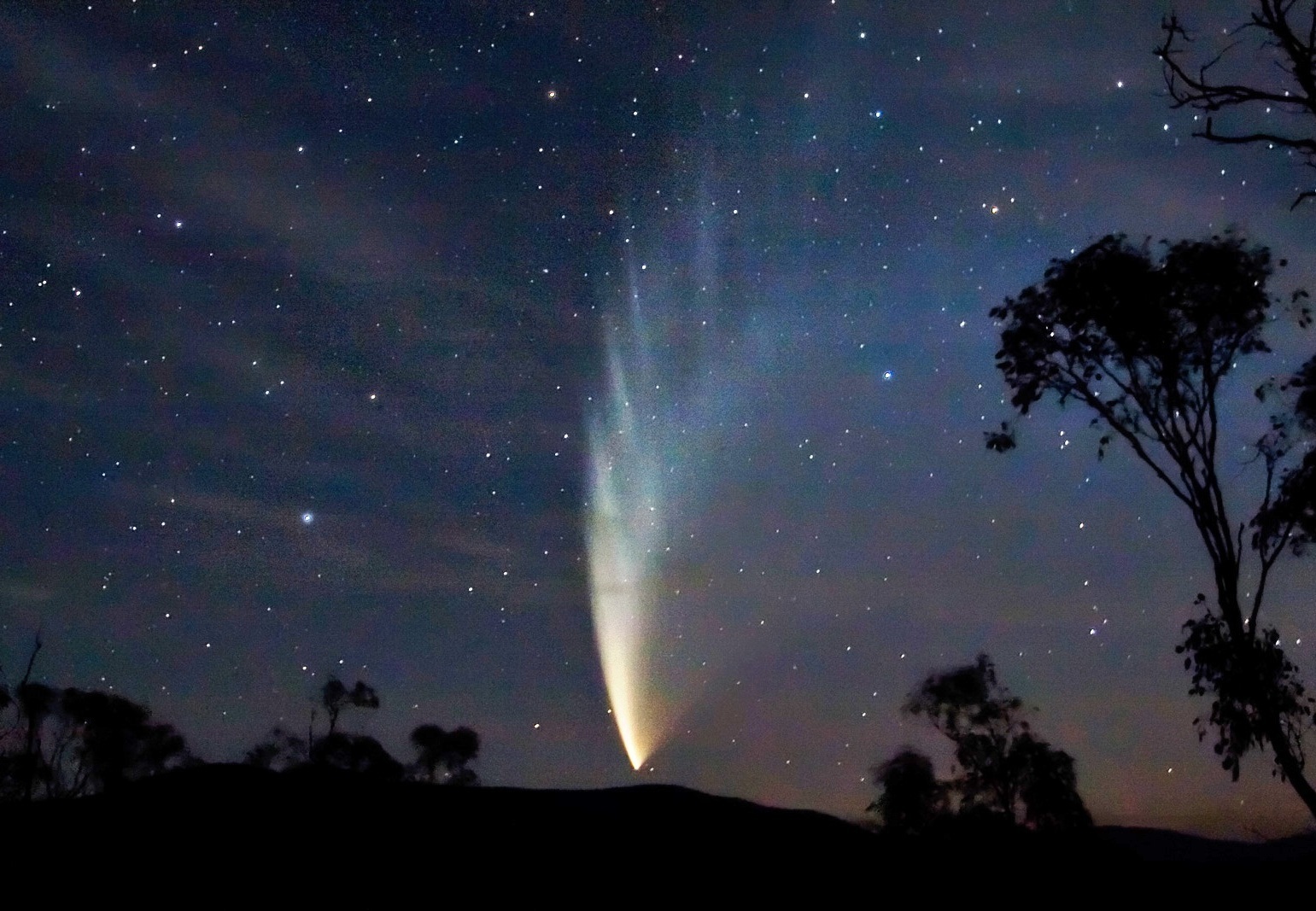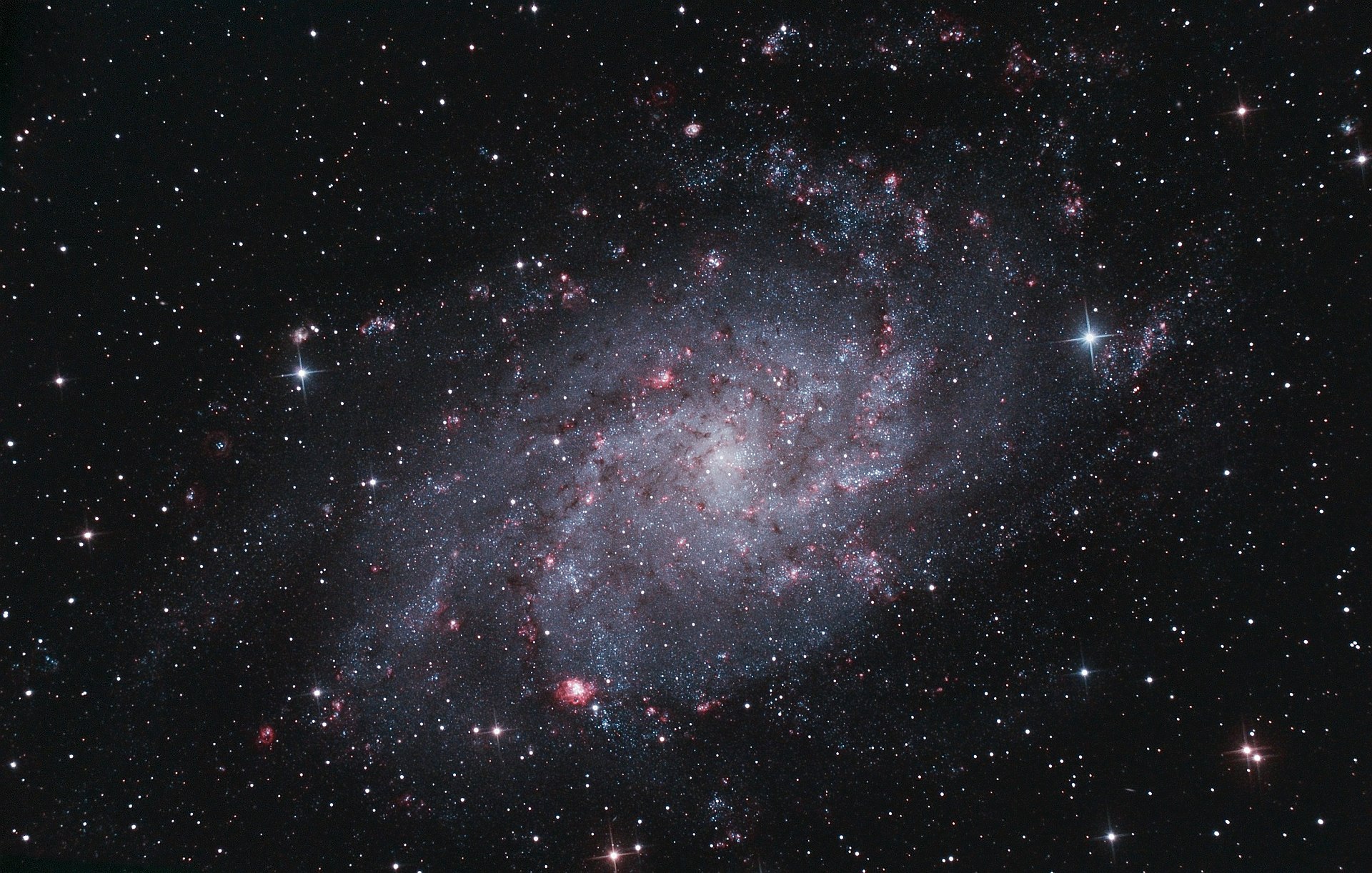4. Over time, from measurements of the photometric and kinematic properties of normal galaxies, it became apparent that there exist correlations between the amount of motion of objects in the galaxy and the galaxy's luminosity. In this problem, we'll explore one of these relationships.
a) Spiral galaxies obey the Tully-Fisher Relation: \(L\sim v^4_{max}\), where L is total luminosity, and \(v_{max}\) is the maximum observed rotational velocity. This relation was initially discovered observationally, but it's not hard to derive:
i. Assume that \(v_{max}~\sigma\). Given what you know about the Virial Theorem, how should \(v_{max}\) relate to the mass and radius of the Galaxy?
The Virial Theorem states that \(M\approx\frac{\sigma^2R}{G}\). Since we're assuming that \(v_{max}\sim\sigma\) (where \(\sigma^2\) is the velocity scatter of the Galaxy), we can just plug it into the equation.
\(M\approx\frac{v^2_{max}R}{G}\)
\(v^2_{max}\propto \frac{M}{R}\)
ii. To proceed from here, you need some handy observational facts. First, all spiral galaxies have similar disk surface brightnesses (\(\langle I\rangle=L/R^2\)) (Freeman's Law). Second, they also have similar total mass-to-light ratios (M/L).
iii. Use some squiggle math to find the Tully-Fisher relationship.
\(v^2_{max}\sim\frac{M}{R}\)
\(v^4_{max}\sim\frac{M^2}{R^2}\)
Through Freeman's Law, \(v^4_{max}\sim\frac{M^2}{(L/I)}\)
\(v^4_{max}\sim\frac{M^2I}{L}\)
We can cancel
M/L because the total mass-to-light ratio is constant between galaxies, so \(v^4_{max}\sim MI\)
Since
M~L, \(v^4_{max}\sim L\), which brings us to the Tully-Fisher relationship.
iv. It turns out the Tully-Fisher relationship is so well-obeyed that it can be used as a standard candle, just like Cepheids and Supernova Ia. In the B-band (blue light), this relation is approximately:
\(M_B=-10log(\frac{v_{max}}{km/s})+3\)
Suppose you observe a spiral galaxy with apparent, extinction-corrected magnitude B=13. You perform longslit optical spectroscopy, obtaining a maximum rotational velocity of 400km/s for this galaxy. How distant do you infer this spiral galaxy to be?
First we plug the observed velocity into the Tully-Fisher relationship to determine its absolute magnitude.
\(M_B=-10log(400)+3=-23\)
We can then use the distance modulus to determine its distance.
\(13-(-23)=5log(\frac{d}{10pc})\)
\(d=1585kpc\)
b) It turns out our Galaxy is not unique in hosting a supermassive black hole (SMBH) in its center. Peering deeply into the galaxies around us, we find that having a central compact region occupied by a SMBH is a common phenomenon. The SMBH appears to be deeply connected with the overall nature of its galaxy. The \(M-\sigma\) relation: \(M_{SMBH}\propto\sigma^4_e\), correlates the mass of the black hole (\(M_{SMBH}\)) with the velocity dispersion of the galactic bulge (\(\sigma_e\)). For elliptical galxies, \(\sigma_e\) refers to that of the velocity dispersion of the entire galaxy. The \(M-\sigma\) relation is:
\(M_{SMBH}=1.35*10^8M_\odot[\frac{\sigma_e}{200km/s}]^4\)
i. Using the rotation velocity profile in the inner 1", estimate the mass enclosed. Recall Andromeda is 770kpc from us.
Looking at the graph above for
R = 1.0,
v looks to be about 200km/s. We also need to convert the radius to parsecs, which we can do using the small-angle approximation.
\(1as=4.8*10^{-6}\)
\(tan(\frac{x}{770kpc})=\frac{x}{770}=4.8*10^{-6}\)
\(x=3.7pc\)
We can now use Virial Theorem to determine the mass: \(M_{tot}=\frac{v^2_{max}R}{G}\).
\(M_{tot}=\frac{(200km/s)^2(3.7pc)}{4.302*10^{-3}pc(km/s)^2/M_\odot}=3.4*10^7M_\odot\)
ii. Using the velocity dispersion in the inner 1", estimate the mass enclosed.
It looks like the dispersion at 1" is about 100km/s. We can use the Virial Theorem again.
\(M_{tot}=\frac{(100km/s)^2(3.7pc)}{4.302*10^{-3}pc(km/s)^2/M_\odot}=8.6*10^6M_\odot\)
iii. Using the average velocity dispersion over the entire range of the plot, deduce the mass of the central supermassive black hole with the \(M-\sigma\) relation.
Over the plot, the average dispersion looks to be about 200km/s.
\(M_{SMBH}=1.35*10^8M_\odot[\frac{200km/s}{200km/s}]^4=1.35*10^8M_\odot\)
iv. Estimate the mass of the SMBH using the velocity dispersion in the inner 0.1".
If we assume the dispersion is 200km/s, we can use the Virial Theorem again, after adjusting the radius.
\(M_{SMBH}=\frac{(200km/s)^2(0.37pc)}{4.302*10^{-3}pc(km/s)^2/M_\odot}=3.4*10^6M_\odot\)











.jpg/1920px-Andromeda_Galaxy_(with_h-alpha).jpg)


.jpg/1024px-Irregular_galaxy_NGC_1427A_(captured_by_the_Hubble_Space_Telescope).jpg)





